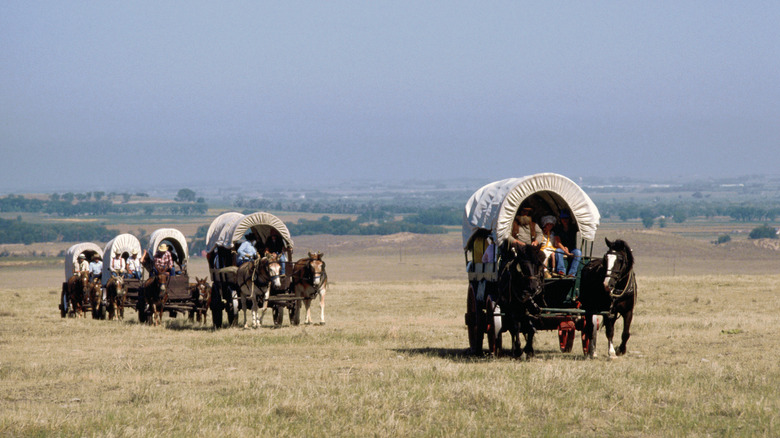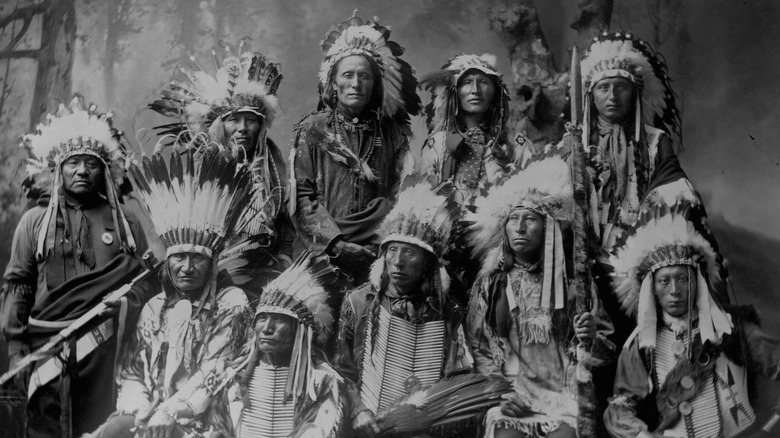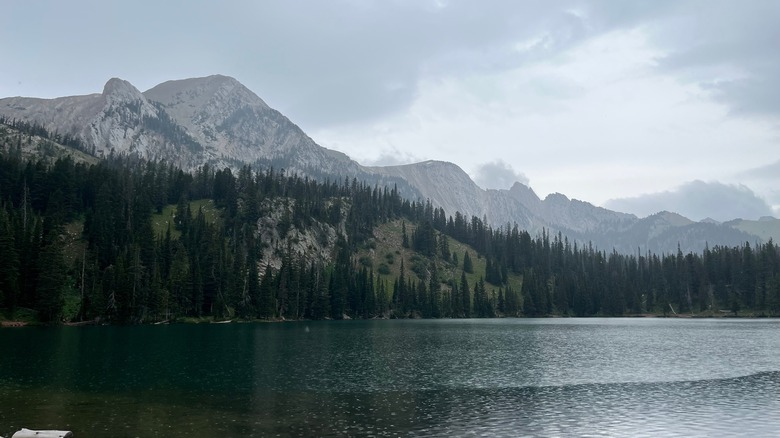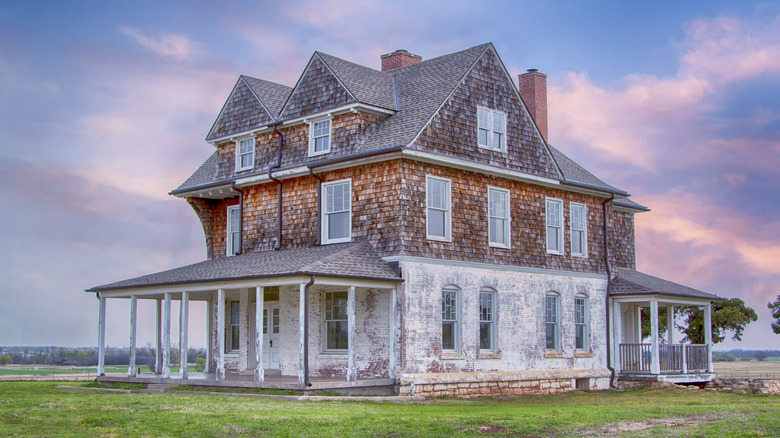The Alternative To Traveling The Oregon Trail That Was A Catastrophic Failure
Tales of the Oregon Trail (1841 to 1884) have captured the imagination for generations, from its legendary 1980's video game incarnation all the way to the present. Maybe it's the mythmaking appeal of self-made, rugged individuals charting their way westward across a vast grassland in search of a better life. Of course, there was nothing idyllic or even remotely appealing about walking — yes, walking — about 2,200 miles along with 300,000 to 500,000 other people, many of whom are dying from disease or starvation at a rate of about 10 to 15 people every mile. Even so, there were other similarly disastrous options — like the Bozeman Trail.
The Bozeman Trail broke off from the Oregon Trail around modern-day Glenrock, Wyoming and terminated near Virginia City near Nevada's southwestern corner. The Oregon Trail, in fact, splintered off at multiple junctions over time as travelers found different, better, and less dusty routes to travel. Some groups even had their own paths, like the Mormon Trail that ended in — you guessed it — Salt Lake City.
There was one problem with the Bozeman Trail, though, as the National Parks Service explains: It cut through Native American territory not open to travelers. In 1864, less than one year after Pioneer John Bozeman first carved the trail, 2,000 settlers followed behind him largely in the hopes of discovering gold. Fast-forward to 1868 and the U.S. Army had plunked down some forts on the trail, lost fights against Indigenous tribesmen, and the Bozeman Trail was abandoned.
No trespassing on Sioux land
Native American tribes along the Oregon Trail generally left settlers alone or engaged in friendly trade. All in all, as the National Oregon/California Trail Center says, records indicate that 362 pioneers died from tribal attacks from 1840 to 1860, largely along one certain stretch of the route starting west of Wyoming. While such numbers aren't foolproof, that's 362 versus 20,000 to 30,000 from other causes like disease and starvation. These tribes included the Shoshone, Crow, Sioux, Kiowa, Ute, and Paiute.
The Bozeman Trail, on the other hand, crossed through land belonging to the Lakota Sioux. And we say "belonging" because the land didn't only consist of traditional hunting grounds — the U.S. government agreed to legally grant it to the Sioux as part of the 1851 Horse Creek Treaty. As the Wyoming Historical Society recounts, a bunch of tribes were involved in these proceedings, including the Cheyenne, Arapaho, Assiniboine, Hidatsa, Arikara, Mandan, Blackfeet, and more, represented by a total of 21 chiefs. Each group got a different parcel of land as well as $50,000 in damages per year — a whopping $2 million modernly — for 50 years.
Naturally, the treaty lasted about two minutes before settlers kept trundling on regardless of who owned what. This type of treaty violation was well underway by the time John Bozeman and his friend John Jacobs forged out onto the Bozeman Trail. In response, the Sioux joined with the Arapaho and Northern Cheyenne and took up arms.
The 1862 Montana Gold Rush
On one hand we've got Native American tribes like the Lakota Sioux wanting to protect tribal hunting grounds, particularly in Wyoming's Powder River Basin. And on the other hand we've got settlers wanting ... Well, gold. As PBS explains, settlers struck gold at Grasshopper Creek, Montana in 1862. The gold rush town Bannack rose overnight, and the next year in 1863 nearby Virginia Springs rose up much the same. A "wealthy but lawless" area where "vigilante justice" prevailed, Virginia Springs nonetheless had 10,000 inhabitants by 1864. Lots of folks wanted in on the action, including John Bozeman.
Bozeman himself apparently didn't have too much luck with the whole striking rich via gold thing. Instead, he opted for being a travel guide for folks he could rope into diverging from the Oregon Trail. In 1863 he widened his self-named Bozeman Trail all the way from the Oregon Trail to Virginia City. He made his money charging fees to those traveling groups and to prospectors he intercepted and led to Montana's newest boomtown.
As we said, Bozeman's path cut through treaty-protected, Native Americans lands. On his very first trip guiding wagoneers, a group of Sioux and Cheyenne stopped him and issued a warning to turn back or be killed. Bozeman didn't turn back, of course, which kicked off what's been dubbed Red Cloud's War (after a leading Lakota Sioux chief). Settlers continued to travel Bozeman's Trail for years and get into numerous violent conflicts with tribesmen. By 1866, the U.S. Army had intervened and made things a whole lot worse.
Forts, a new treaty, and an abandoned trail
Things went about as well as you'd expect when the U.S. Army started building forts along the Bozeman Trail to protect settlers who were in violation of a treaty against Native American tribes. They built Fort Reno, Fort Phil Kearney, and Fort C.F. Smith in 1866, the year after the U.S. Civil War ended. As the National Park Service says, this effectively transformed the Bozeman Trail into a military road. Amongst endless smaller skirmishes, three conflicts in particular soured the Army on protecting the Bozeman Trail: the Fetterman Fight, the Hayfield Fight, and the Wagon Box Fight. The last battle — fought in 1867 — stands out because it featured 19 soldiers and 6 civilians holding off against 500 native warriors for about eight hours straight.
To make a long story short: The Bozeman Trail simply wasn't worth it. Soldiers who stayed at the forts started losing their minds from the constant tension and threat of attack, especially at Fort C.F. Smith, as the National Park Service explains. Ultimately, the U.S. signed yet another treaty — the Fort Laramie Treaty of 1868 — that saw the Army abandon their forts along the Bozeman Trail and once again vow to keep their hands off Indigenous hunting grounds. As for John Bozeman, PBS says that he gave things up early in 1864, settled near his own self-named pass, and founded yet another thing named after him: Bozeman, Montana. He died three years later while traveling along the Yellowstone River.



